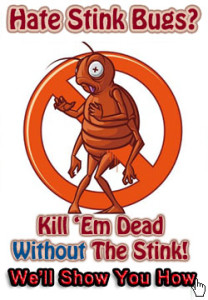Stink bugs get their name because they have the dubious distinction of being one of the rare members of the insect kingdom who emit a foul odor as a deterrent against imminent threats. This odor is used to stave off most predators who try to assault them, not unlike how a skunk might emit its noxious odors when they feel threatened by a marauder looking to hunt them down. It is for this reason, it is believed, that stink bugs do not have any known predators in the wild (unless you count wasps, which prey upon unhatched stink bug eggs as opposed to living stink bugs). Killing stink bugs comes with a trade off: You get sprayed by a puff of noxious odors.
Now if you have ever come into contact with a stink bug and tried to squash it, then you no doubt have smelled their trademark odor. Some people say it doesn’t bother them. Some people say it is extremely nasty and putrid. And then there are even some people who say that the odor that stink bugs emit bears a striking resemblance to the smell of cilantro. Well, that is not a coincidence. It just so happens to be that the chemical that is released by stink bugs is composed of trans-2-decenal and trans-2-octenal. This is the same chemical compound that is found in cilantro!
And that is what makes killing stink bugs so challenging: If you try to sqaush them, you could end up with that odor on your hands, your clothes, your furniture, your flooring or walls. And that is perhaps the last thing you want to do, as the residual odor is known to serve as a signal for other stink bugs to come closer.
If your home has been infiltrated by a huge swath of stink bugs, then you may have noticed that they generally tend to stick together in clusters. How do they do that? They do that by releasing what is known as an aggregation pheromone. This aggregation pheromone should not be confused with the self-defense cilantro-smelling odor that they emit when they are threatened. This pheromone is entirely different. It is used to attract other stink bugs, much like a homing beacon, so they can find each other and form clusters like they do. Stink bugs are always on the prowl, in search of warm, and bright places to take up domicile. When other stink bugs are flying by, and they detect that pheromone, they will take the presence of that chemical to mean that there are other stink bugs nearby who have already “blazed the trail” and found such a place for them that is habitable and hospitable.
For many people, this can spell disaster: The last thing you would want to do is to kill one stink bug, only to have a whole army of stink bugs come to take its place. But on the other hand, it is possible to use stink bugs’ weapon of self-defense against them.
Yes, it’s true. Think about it. Stink bugs will instinctively flock toward wherever the source of the aggregation hormones are emanating from. So if we, as humans, chose to, we can leverage this to our advantage. We can set up a trap! The idea is so elementary as to be flawless in nature!
By attracting more stink bugs toward one particular location, you could then entrap them within an enclosure. Or you could get them stuck to some adhesive fly paper or even industrial strength duct tape. Or you could drown them in a container filled with dish soap or dish detergent (which has been known to be lethal to stink bugs). You can get really creative with this.
So the question is: How exactly do you kill stink bugs by using their own pheromones against them? Well, one way would be simply to set up a trap near an existing cluster of stink bugs. Another would be to set up a stink bug pheromone trap, which you could either construct yourself or which you can buy commercially. You can buy synthetically engineered stink bug pheromone sprays. Essentially, you lure stink bugs into an encasing with a trap door from which the pheromone is being released into the atmosphere. And then when enough of these bugs have entered into the encasing, you can then shut the trap door. You can then dispose of these bugs as you see fit. The encasing doesn’t have to be anything fancy. It could be anything as simple as a jar or a bottle, with an odor dispenser placed inside it.
Fortunately, these pheromones are odorless to humans, but stink bugs are highly sensitive to them.
So there’s no sense in feeling helpless and frightened in the face of a horde of stink bugs. There are many ways how to kill stink bugs can kill stink bugs by using their own pheromones against them. Any variation of the method described above will do, as long as you have a source that emits the pheromones and any type of receptacle that can be used to capture and encase them.

 There are many different strategies for
There are many different strategies for